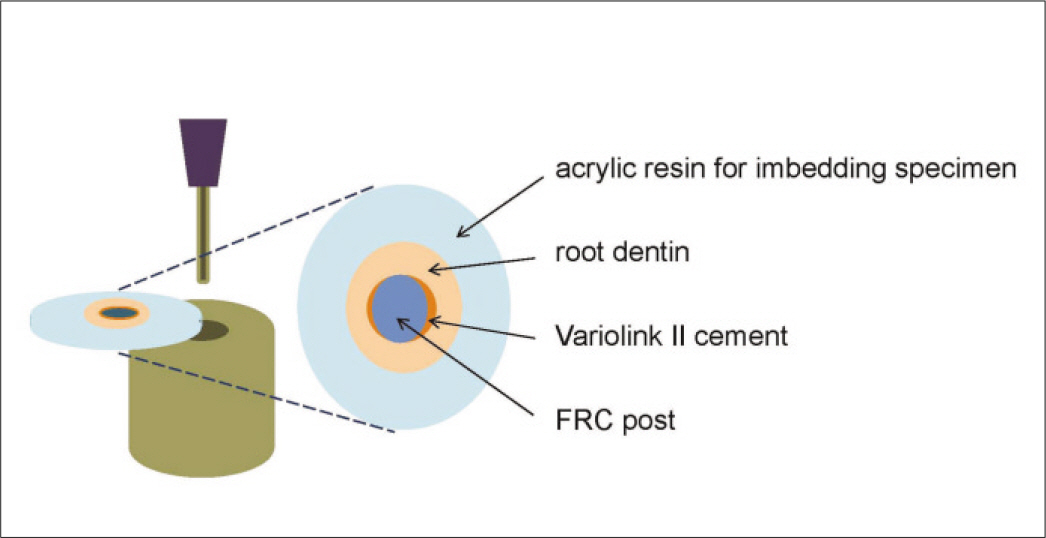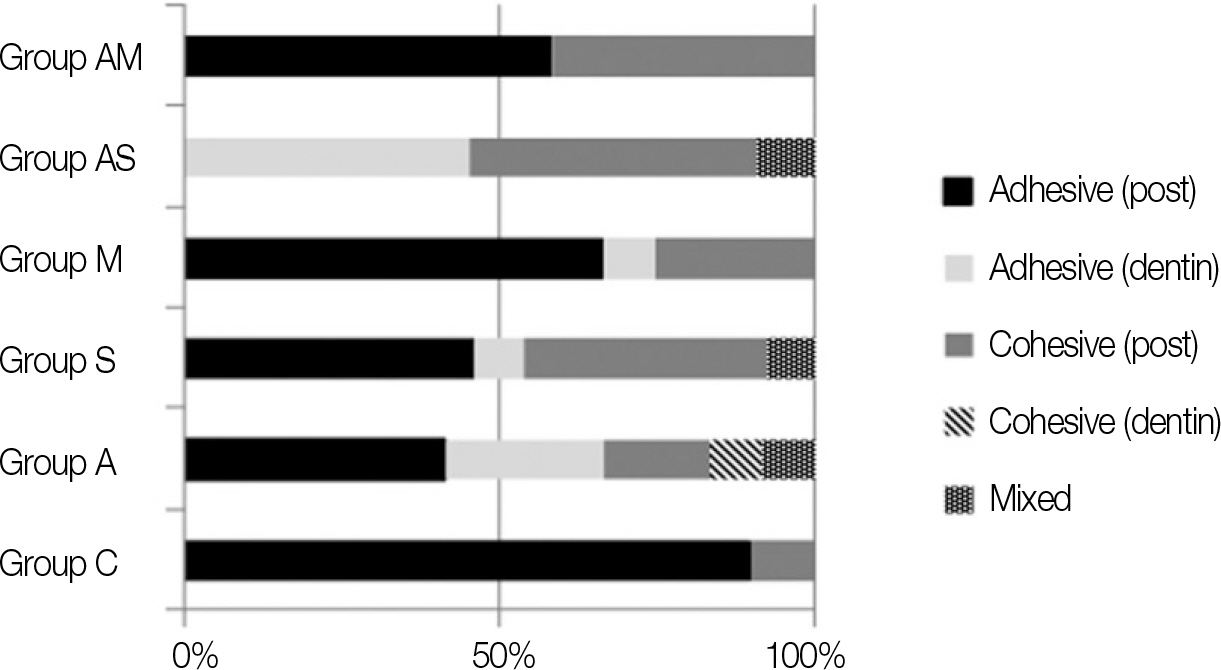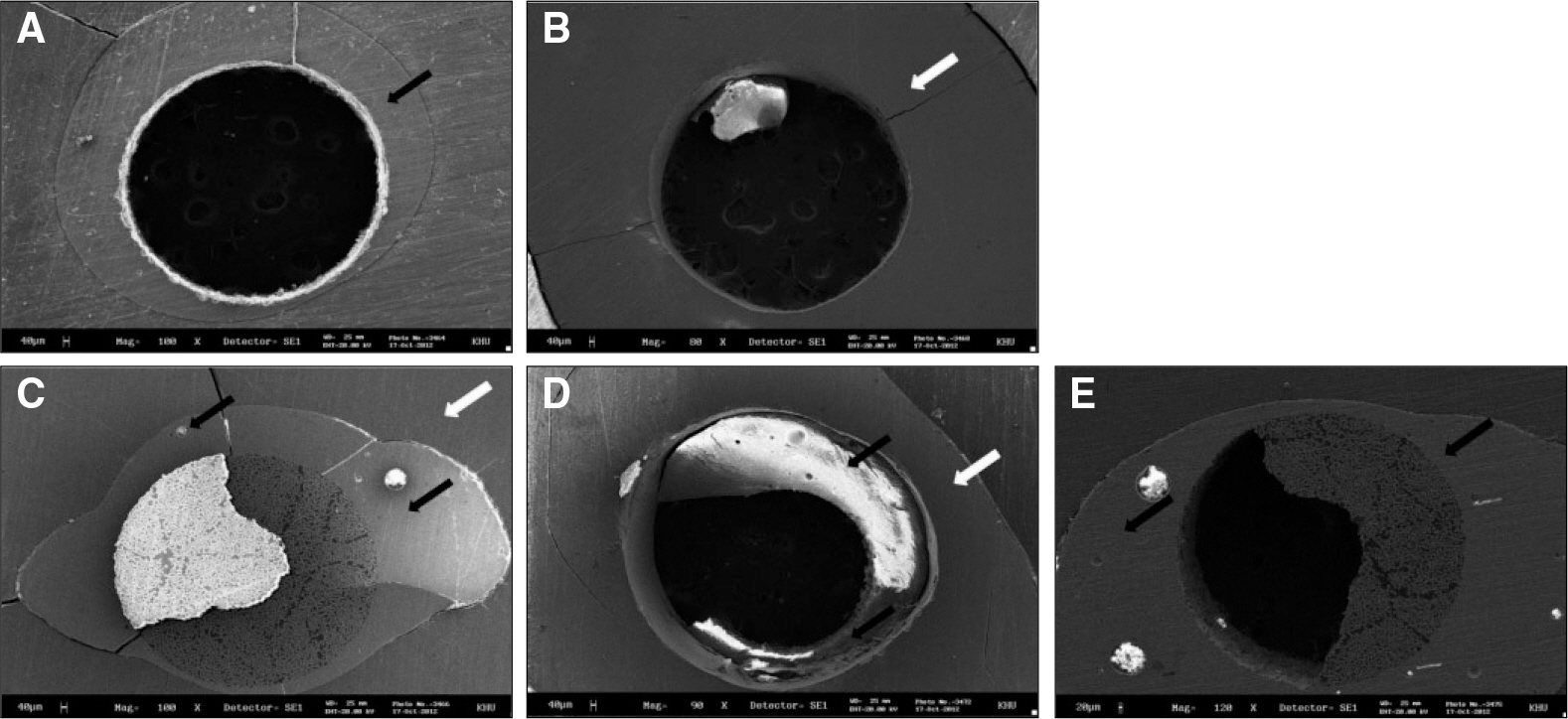J Korean Acad Prosthodont.
2014 Apr;52(2):113-120. 10.4047/jkap.2014.52.2.113.
Retentive bond strength of fiber-reinforced composite posts cemented with different surface treatments
- Affiliations
-
- 1Department of Prosthodontics, School of Dentistry, Kyung Hee University, Seoul, Republic of Korea. ahranp@khu.ac.kr
- KMID: 2000137
- DOI: http://doi.org/10.4047/jkap.2014.52.2.113
Abstract
- PURPOSE
This study will evaluate the effectiveness of various pretreatments when fiber-reinforced composite (FRC) post is bonded to endodontically treated tooth with resin cement.
MATERIALS AND METHODS
Canal shaping of FRC post (DT Light post, Size 3, Bisco Inc., Schaumburg, IL, USA) was performed on endodontically treated premolars at 1.5 cm from CEJ. Samples were divided into 6 groups of surface treatment after conventional washing and drying to the canal. Total of 24 FRC posts were randomly divided into 6 groups of surface treatment as follows: Group C: control - no surface treatment, Group A: airborne-particle abrasion (Cojet sand, 3M ESPE), Group S: silanization (Bis-silane, Bisco Inc.), Group M: universal primer (Monobond-plus primer, Ivoclar Vivadent Inc.), Group AS: silanization after airborne-particle abrasion, Group AM: universal primer treatment after airborne-particle abrasion. Pretreated fiber posts were cemented with resin-based luting material and photo-polymerized and cut to the thickness of 1 mm. Push-out test using a universal testing machine was performed. Bonding failure strength of post dislodgement was measured and the type of bonding failure was classified. Data were analyzed with Kruskal-Wallis test and multiple comparison groups were performed using Tukey HSD value of rank test (alpha=0.05).
RESULTS
Group AS showed significantly highest bonding strength. Group S, group AM, group A, and group M showed lower bonding strength in order. The control group showed the lowest bonding strength.
CONCLUSION
Surface treatment with silane showed to be the most effective of the surface pretreatment methods for cementation of FRC post. Surface treatment with universal primer showed no significant difference compared with no surface treatment group as for bonding strength.
MeSH Terms
Figure
Cited by 1 articles
-
Effect of different adhesive systems and post surface treatments on the push-out bond strengths of fiber-reinforced post
Min-Woo Kim, Jin-Hee Ahn, Lee-Kyoung Kim, Hye-Won Shim
J Korean Acad Prosthodont. 2016;54(3):218-225. doi: 10.4047/jkap.2016.54.3.218.
Reference
-
1.Rathke A., Haj-Omer D., Muche R., Haller B. Effectiveness of bonding fiber posts to root canals and composite core build-ups. Eur J Oral Sci. 2009. 117:604–10.
Article2.Bitter K., Kielbassa AM. Post-endodontic restorations with adhesively luted fiber-reinforced composite post systems: a review. Am J Dent. 2007. 20:353–60.3.Vichi A., Ferrari M., Davidson CL. Influence of ceramic and cement thickness on the masking of various types of opaque posts. J Prosthet Dent. 2000. 83:412–7.
Article4.Torbjo¨rner A., Karlsson S., Syverud M., Hensten-Pettersen A. Carbon fiber reinforced root canal posts. Mechanical and cytotoxic properties. Eur J Oral Sci. 1996. 104:605–11.
Article5.Goracci C., Ferrari M. Current perspectives on post systems: a literature review. Aust Dent J. 2011. 56:77–83.
Article6.Monticelli F., Osorio R., Sadek FT., Radovic I., Toledano M., Ferrari M. Surface treatments for improving bond strength to prefabricated fiber posts: a literature review. Oper Dent. 2008. 33:346–55.
Article7.Kurt M., Gu¨ler AU., Duran I ¨. Effects of different surface treatments on the bond strength of glass fiber-reinforced composite root canal posts to composite core material. J Dent Sci. 2012. 7:20–5.
Article8.Yenisey M., Kulunk S. Effects of chemical surface treatments of quartz and glass fiber posts on the retention of a composite resin. J Prosthet Dent. 2008. 99:38–45.
Article9.Albashaireh ZS., Ghazal M., Kern M. Effects of endodontic post surface treatment, dentin conditioning, and artificial aging on the retention of glass fiber-reinforced composite resin posts. J Prosthet Dent. 2010. 103:31–9.
Article10.Balbosh A., Kern M. Effect of surface treatment on retention of glass-fiber endodontic posts. J Prosthet Dent. 2006. 95:218–23.
Article11.Choi Y., Pae A., Park EJ., Wright RF. The effect of surface treatment of fiber-reinforced posts on adhesion of a resin-based luting agent. J Prosthet Dent. 2010. 103:362–8.
Article12.Jongsma LA., Kleverlaan CJ., Feilzer AJ. Influence of surface pretreatment of fiber posts on cement delamination. Dent Mater. 2010. 26:901–7.
Article13.Kim NH., Shim JS., Moon HS., Lee KW. Effect of universal primer on shear bond strength between resin cement and restorative materials. J Korean Acad Prosthodont. 2012. 50:112–8.
Article14.Attia A., Kern M. Long-term resin bonding to zirconia ceramic with a new universal primer. J Prosthet Dent. 2011. 106:319–27.
Article15.Taira Y., Sakai M., Sawase T. Effects of primer containing silane and thiophosphate monomers on bonding resin to a leucite-reinforced ceramic. J Dent. 2012. 40:353–8.
Article16.Kato H., Matsumura H., Tanaka T., Atsuta M. Bond strength and durability of porcelain bonding systems. J Prosthet Dent. 1996. 75:163–8.
Article17.Hooshmand T., van Noort R., Keshvad A. Storage effect of a pre-activated silane on the resin to ceramic bond. Dent Mater. 2004. 20:635–42.
Article18.Monticelli F., Toledano M., Osorio R., Ferrari M. Effect of temperature on the silane coupling agents when bonding core resin to quartz fiber posts. Dent Mater. 2006. 22:1024–8.
Article19.Bitter K., Noetzel J., Neumann K., Kielbassa AM. Effect of silanization on bond strengths of fiber posts to various resin cements. Quintessence Int. 2007. 38:121–8.20.Schmage P., Cakir FY., Nergiz I., Pfeiffer P. Effect of surface conditioning on the retentive bond strengths of fiberreinforced composite posts. J Prosthet Dent. 2009. 102:368–77.
Article21.Chai J., Chu FC., Chow TW. Effect of surface treatment on shear bond strength of zirconia to human dentin. J Prosthodont. 2011. 20:173–9.
Article22.Anagnostopoulos T., Eliades G., Palaghias G. Composition, reactivity and surface interactions of three dental silane primers. Dent Mater. 1993. 9:182–90.
Article
- Full Text Links
- Actions
-
Cited
- CITED
-
- Close
- Share
- Similar articles
-
- Comparative evaluation of effects of different surface treatment methods on bond strength between fiber post and composite core
- Currently there are so many fiber reinforced composite posts in the market. Some products are factory silanated but some products are not. Should I use silane for surface treatment of fiber reinforced composite posts?
- Effect of different adhesive systems and post surface treatments on the push-out bond strengths of fiber-reinforced post
- Effect of surface treatments of fiber posts on bond strength to composite resin cores
- Effect of antioxidants on push-out bond strength of hydrogen peroxide treated glass fiber posts bonded with two types of resin cement





